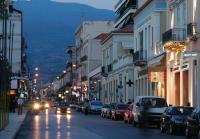 Aristomenous street Aristomenous street, which was constructed in 1871 and was originally named “Paralia-Kalamon National Road (or Highway),” begins at March 23 Square. It was the first road connecting the city as it was then to the coast, and remains to this day the main road and a reference point for the town. The broadening of Aristomenous street gave a significant boost to the city’s trade and construction sectors. The original (northern) section of the street and those leading off it concentrate a significant number of neoclassical buildings, while the main square, several public services and the Railway Park are also located along it. 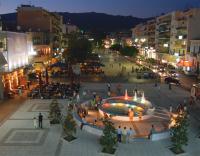 The south side of the main square Heading down Aristomenous street towards the main square and the coast brings us to the corner of Aristomenous and Kolokotroni streets. At east we see the Church of Aghios Nikolaos Filarios, one of Kalamata’s first modern churches, built in 1860, around about the same time as the churches of Ypapanti tou Sotiros and Aghios Ioannis Prodromos. 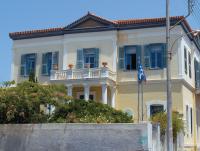 The
Tsingos
building The parish of Aghios Nikolaos contains a number of neoclassical buildings, many of which house public services. The most striking of these is located beside the church, by its southern side. The Tsingos building is an impressive compound, which is dated to the 1890-1910 period. Two-stories high on the Aristodimou side and three on Aghiou Nikolaou, the compound is comprised of two adjoining neoclassical buildings and a third built in the local folk style. Returning to Aristomeous and continuing our walk takes us to Kalamata City Hall
(Aristomenous & H. Koumandou), a two-story tileroofed eclectic building of the 1890s, formerly the mansion of a wealthy local merchant, Panayiotis Psaltis. King George briefly stayed here in 1898, while the building also housed the National Bank for several years. Noteworthy characteristics in the building’s architecture are the northern Italian influences, the symmetry of specific elements in combination with the overall asymmetry of the building, while it also has impressive marble balconies with sculpted cornices and wrought-iron railings. 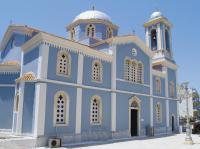 The Church of Aghios Nikolaos Flarios Right next to the City Hall to the north, is the historic Hotel Rex, an elegant four-storey neoclassical edifice with symmetrical windows and doors, located on the corner of Aristomenous and Nedontos. Founded under the name “Panellinion” in 1899, the hotel has now been fully renovated and provides excellent facilities and services, paying homage to its rich history. As we continue down Aristomenous, it is worth taking a look at the Londos and Varvoutsi arcade, on the east side of the street, full of people and activity. 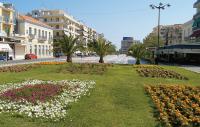 The small
botanical
gardens
in the main
square Further down, on the corner of Aristomenous and Nikitara, lies another neoclassical building, this one belonging to the National Bank of Greece (1890-1910), with two stories, a ceramic-tiled roof, symmetrical framed windows and doors, an entrance adorned with a marble frame and a balcony with a parapet above. 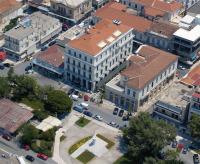 The City Hall from the west
(Nedontos street) The Municipal Cultural Center of Kalamata “Pantazopouleios School”, is located further down the road at 33 Aristomenous. The building is home to the Kalamata Popular Library, the Gallery of Contemporary Greek Art and also has an amphitheater. The two-storey neoclassical building, bequeathed to the city by Kalamata noblewoman Regina, widow of N. Pantazopoulos (nee Alvanaki), was constructed in 1910-11. It features a parapet and a pediment crown. The middle section of the entrance has a roofed area supported by four marble columns, which together create three semi-circular chambers. The building has a marble base and decorative columns at its corners. It stands apart from the parapet, which has a succession of architraves. 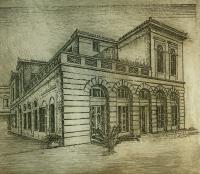 Kalamata
1996,
Panayiotis
Gravalos Piraeus Bank, another two-storey neoclassical building, is located on the corner of Aristomenous and Polyharous. This brings us to an impressive, long square, which is the city’s main square. Flowerbeds, lawns and trees, as well as statues honouring the fighters of the Greek War of Independence adorn the northern end of the square, while the central part is dotted with pastry shops and cafes, which – in combination with its natural beauty – make it one of the most popular spots in town. The southern end of the square, dubbed by locals as “Psarakia” (or little fish) because of its new water fountain, is also a lovely spot. 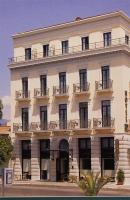 Τhe facade of
the historical
Hotel Rex Heading west from Psarakia and the main square brings us to the Railway Station, with Papaflessa square at its north and impressive neoclassical buildings surrounding it. The most impressive architectural elements of the public railroad station’s (OSE) building (1910) belong to the eclectic style and include symmetrical openings, which are framed and have lintels, a gabled roof and large clock, corners with rustic masonry and overhangs under the roof. Returning to the central square and walking down Aristomenous (on its western side) brings us first to the Municipal Theater (Aristomenous & Dimosthenous) and then the Courthouse and the Government House, which houses the local headquarters of the regional administrator and prefect, as well as a number of other public services. Across the street from the Governement House is the newly built Worker’s Center. 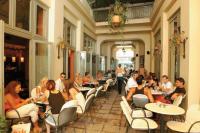 The Londos arcade Following this route will bring us to the Railway Park, the first theme park of its kind to operate in Greece, inaugurated in 1986. The beautiful Railway Park covers an area of 5.4 hectares that includes small hills, lakes, fountains, sports grounds, playgrounds, an open-air amphitheater, a chess area, skating rink and a lot more. Visitors to the Railway Park can enjoy a display of trains, engines, etc., that have been arranged in a manner that allows them to travel around the park. Park authorities have also renovated the old two storey station house, four passenger platforms – paved in the characteristic red paving stones of the OSE railway organization –, the stone-based water tower and a metallic pedestrian bridge that is 28 meters long. 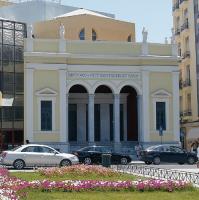 The Municipal
Cultural Center of
Kalamata –
“Pantazopouleios”
School 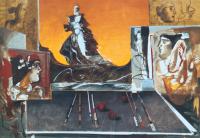 Composition, Demetres
Mytaras (Gallery
of Contemporary
Greek Art) 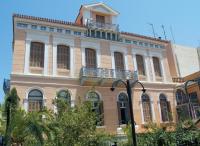 The Zoumpouleio Mansion |